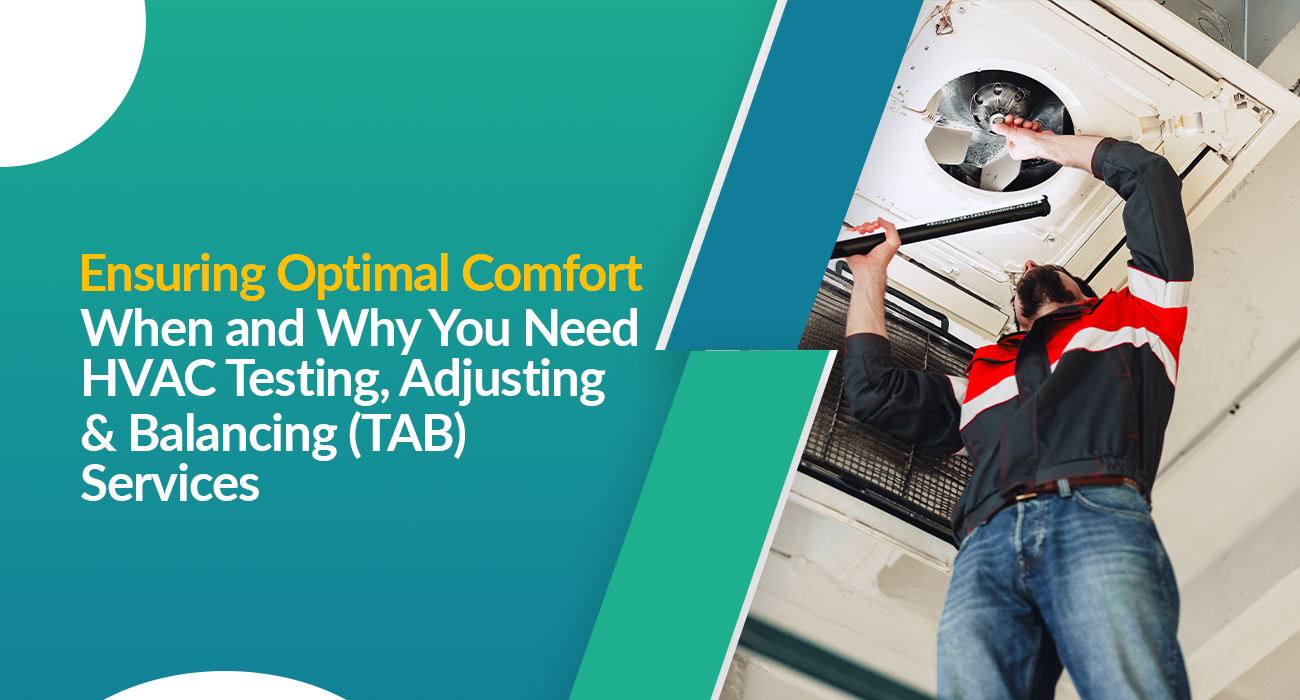
Ensuring Optimal Comfort: When and Why You Need HVAC Testing, Adjusting & Balancing (TAB) Services
Heating, ventilation, and air conditioning (HVAC) systems are more than just appliances that control temperature—they are critical for maintaining comfort, indoor air quality, and energy efficiency in any building. However, even the most modern HVAC system cannot operate at peak efficiency without professional calibration. This is where HVAC Testing, Adjusting & Balancing (TAB) services become essential. These services ensure that your system performs as designed, delivering consistent comfort and energy savings while extending the life of your equipment.
What HVAC Testing, Adjusting & Balancing (TAB) Entails
HVAC Testing, Adjusting & Balancing (TAB) is a specialized process performed by trained technicians to verify and optimize the performance of HVAC systems. The process includes three main components:
- Testing: Technicians measure the system’s performance, including airflow, temperature, pressure, and humidity. Testing identifies imbalances, underperforming components, or system inefficiencies.
- Adjusting: Based on test results, precise adjustments are made to system components such as dampers, fan speeds, and valves to meet design specifications.
- Balancing: Ensures that airflow is distributed evenly throughout all zones of a building. Proper balancing prevents some areas from being too hot or too cold and maintains system efficiency.
Without proper TAB services, even a brand-new HVAC system may underperform, causing discomfort, higher energy bills, and premature wear on equipment.
When You Should Schedule HVAC Testing, Adjusting & Balancing (TAB)
Knowing the right time to schedule TAB services can help prevent issues before they become costly problems. Key scenarios include:
- After a New Installation: New HVAC systems require TAB services to verify that installation meets design specifications. This ensures airflow, pressure, and temperature are distributed correctly.
- Post Renovation or System Upgrades: Any modifications to ductwork, fan systems, or HVAC components can affect airflow and efficiency. TAB recalibrates the system to maintain optimal performance.
- Before Peak Seasons: Conducting TAB services before the hottest summer months or coldest winter periods ensures your HVAC system is ready to handle temperature extremes efficiently.
- Experiencing Comfort Issues: If you notice uneven temperatures, drafts, hot or cold spots, or noisy vents, TAB can identify the root cause and restore balanced airflow.
- Energy Efficiency Optimization: Imbalances in HVAC systems increase energy consumption. TAB services improve energy efficiency, lowering utility costs while maintaining comfort.
The Importance of HVAC Testing, Adjusting & Balancing (TAB)
- Consistent Indoor Comfort: Properly balanced systems ensure even heating or cooling across all zones, preventing hot or cold spots in the building.
- Better Air Quality: TAB ensures proper airflow, which reduces dust, allergens, and airborne pollutants. This is critical for creating healthy indoor environments, especially in offices, hospitals, and schools.
- Reduced Energy Costs: An imbalanced HVAC system works harder to reach desired temperatures. TAB optimizes airflow, reducing energy consumption and operational costs.
- Extended Equipment Lifespan: When airflow is uneven, components like fans, motors, and compressors experience unnecessary strain. TAB reduces wear, extending the system’s life.
- Regulatory Compliance: Many commercial buildings must meet local and international standards for airflow and energy efficiency. TAB services ensure compliance with these regulations.
- Proactive Problem Prevention: Regular TAB inspections help identify potential system failures early, avoiding costly emergency repairs and downtime.
How HVAC Testing, Adjusting & Balancing (TAB) Works
- Initial Evaluation: A TAB contractor performs a detailed assessment of the HVAC system, including air handling units, ductwork, diffusers, and fans. This step identifies problem areas and establishes baseline performance.
- Precise Measurement: Using specialized tools, technicians measure airflow, static pressure, temperature, and humidity at multiple points. This data is crucial for understanding system performance.
- Component Adjustment: Dampers, fans, and valves are adjusted based on measured data to ensure each zone receives the proper airflow and temperature.
- System Balancing: Airflow is fine-tuned to maintain uniform conditions across all rooms or zones, eliminating hot and cold spots.
- Verification and Reporting: After adjustments, the system is retested to confirm performance improvements. Comprehensive reports document airflow, pressure, and temperature levels for future reference.
Signs That Your HVAC System Needs TAB Services
- Uneven Temperatures: Significant temperature differences between rooms or zones indicate imbalances.
- High Energy Bills: A sudden increase in electricity usage may be caused by an inefficient system.
- Noisy Operation: Loud fans, rattling ducts, or vibrating vents can signal airflow issues.
- Weak or Inconsistent Airflow: Reduced airflow at vents often points to duct or system imbalances.
- Humidity Problems: Excess moisture or dry air may result from improper airflow or a system that isn’t calibrated.
Selecting the Right TAB Service Provider
The effectiveness of HVAC Testing, Adjusting & Balancing (TAB) services depends on the expertise of the provider. Consider the following factors:
- Certification and Experience: Look for contractors trained and certified in TAB procedures with experience in your building type.
- Advanced Tools: Accurate measurements require calibrated instruments for airflow, pressure, and temperature.
- Comprehensive Reporting: Reliable providers deliver detailed reports documenting all findings, adjustments, and recommendations.
- Reputation: Check client reviews, case studies, and references to ensure consistent service quality.
- Standards Compliance: The contractor should follow local regulations and industry standards for airflow and energy efficiency.
Benefits for Both Residential and Commercial Spaces
For commercial buildings, HVAC Testing, Adjusting & Balancing (TAB) enhances employee comfort, supports productivity, and ensures compliance with safety and energy regulations. In residential buildings, TAB improves indoor comfort, air quality, and energy efficiency, reducing utility bills while extending system life. In both scenarios, regular TAB services protect your HVAC investment and maintain long-term system performance.
Conclusion
HVAC Testing, Adjusting & Balancing (TAB) services are a critical part of maintaining an efficient, reliable, and comfortable HVAC system. By measuring, adjusting, and balancing airflow and system components, TAB ensures even temperatures, improved air quality, energy savings, and longer equipment life. Whether you are dealing with a newly installed system, renovations, or performance issues, investing in HVAC Testing, Adjusting & Balancing (TAB) is a proactive way to safeguard your comfort, reduce operational costs, and ensure optimal HVAC performance.




Post a comment